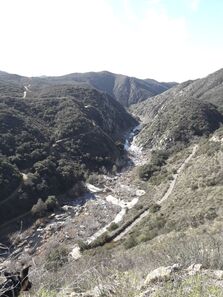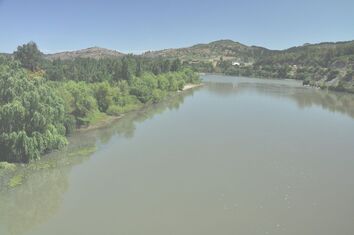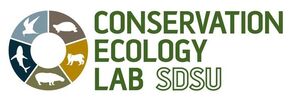|
Isabel M. Rojas, Postdoctoral Research
Email: [email protected] 2019 Ph.D. Forestry, University of Wisconsin - Madison 2013 M.S. Conservation Biology, University of Wisconsin - Madison 2008 Forestry, Pontificia Universidad Católica de Chile 2003 Bachelor in Science, Pontificia Universidad Católica de Chile Research Interest I seek to find ways to balance human’s demands for natural resources with the protection of biodiversity and ecosystem functioning. I have focused my research on understanding the role of riparian ecosystems on the maintenance of biodiversity across working landscapes in Chile, my home country. By combining the tools and theory of landscape ecology, plants and birds ecology and land use planning in spatial analysis, I can synthesis new, interdisciplinary understanding of the function of landscapes that informs sustainable use of the land while simultaneously maintaining biodiversity. |

Connecting Wildlands And Communities
In the Conservation Ecology Lab, I'll be working to identify habitats that can provide refugia from multiple stresses that climate change posed on biodiversity, such as increases in drought and fire events. This research is part of an multi-disciplinary team effort that aim to identify opportunities to plan landscapes that are resilient to climate change. Click here to learn more about the project.
To better quantify the effect of topography on climate variability, we are using climate data collected at various spatial and temporal scale. The picture on the left shows a narrow valley at Santa Margarita Ecological Reserve. Here, we have deployed small data loggers to collect temperature along elevation, aspect and slope gradients. Information from data loggers combined with weather station data and gridded climate data will help us to quantify where complex topography create climate stable refugia that can host suitable habitats for species adapted to colder and wetter conditions.
In the Conservation Ecology Lab, I'll be working to identify habitats that can provide refugia from multiple stresses that climate change posed on biodiversity, such as increases in drought and fire events. This research is part of an multi-disciplinary team effort that aim to identify opportunities to plan landscapes that are resilient to climate change. Click here to learn more about the project.
To better quantify the effect of topography on climate variability, we are using climate data collected at various spatial and temporal scale. The picture on the left shows a narrow valley at Santa Margarita Ecological Reserve. Here, we have deployed small data loggers to collect temperature along elevation, aspect and slope gradients. Information from data loggers combined with weather station data and gridded climate data will help us to quantify where complex topography create climate stable refugia that can host suitable habitats for species adapted to colder and wetter conditions.

Riparian Forest Corridors For Wildlife In Chile
Riparian forests can play an important role in connecting habitat for forest species. In collaboration with Dr. Anna Pidgeon and Dr. Volker Radeloff from the University of Wisconsin, I combined spatial analysis of land use and birds’ density models with restoration scenarios to evaluate where rivers form forested corridors across the landscape. In summary, in landscapes well suited for tree growth, agriculture and topography resulted in little connectivity of the forest in flatlands, where habitat connectivity is most needed. My work identifies options for improving wildlife habitat connectivity in this flatlands. Future conservation strategies could focus on 1) creating habitat for the majority of birds species by adding more small and isolated riparian forests, and/or 2) creating connected habitat, via riparian corridors, that would benefit the specialized species as well. Effective enforcement of riparian buffer protection, as well as restoration, would help provide broad-scale habitat connectivity for forest wildlife.
Riparian forests can play an important role in connecting habitat for forest species. In collaboration with Dr. Anna Pidgeon and Dr. Volker Radeloff from the University of Wisconsin, I combined spatial analysis of land use and birds’ density models with restoration scenarios to evaluate where rivers form forested corridors across the landscape. In summary, in landscapes well suited for tree growth, agriculture and topography resulted in little connectivity of the forest in flatlands, where habitat connectivity is most needed. My work identifies options for improving wildlife habitat connectivity in this flatlands. Future conservation strategies could focus on 1) creating habitat for the majority of birds species by adding more small and isolated riparian forests, and/or 2) creating connected habitat, via riparian corridors, that would benefit the specialized species as well. Effective enforcement of riparian buffer protection, as well as restoration, would help provide broad-scale habitat connectivity for forest wildlife.
Peer-reviewed publications
2017 Ibarra, J.T., N. Gálvez, T.A. Altamirano, J. Caviedes, I.M. Rojas, C. Bonacic and K. Martin. 2017. Seasonal dynamics of avian guilds inside and outside protected areas in an Andean Biosphere Reserve of southern Chile. Bird Study 64(3):410-420.
2015 Rojas, I.M., and J.B. Zedler. An invasive exotic grass reduced sedge meadow species richness by half. Wetlands Ecology and Management 23(4):649-663.
2015 Healy, M.T., I.M. Rojas and J. B. Zedler. Adaptive Control of Phalaris arundinacea in Curtis Prairie. Invasive Plant Science and Management 8(3): 363-373.
2014 Zedler, J.B., J.M. Doherty and I.M. Rojas. Leopold’s Arboretum needs upstream water treatment to restore wetlands downstream. Water 6(1):104- 121.
2012 Ibarra, J.T., N. Gálvez, A. Gimona, T.A. Altamirano, I.M. Rojas, A. Hester, J. Laker and C. Bonacic. Rufous-legged Owl (Strix rufipes) and Austral Pygmy Owl (Glaucidium nanum) stand use in a gradient of disrupted and old growth Andean temperate forest, Chile. Studies on Neotropical Fauna and Environment 47(1):33-40.
2011 Rojas, I.M., P. Becerra, N. Gálvez, J. Laker, C. Bonacic and A. Hester. Relationship between fragmentation, degradation and native and exotic species richness in an Andean temperate forest of Chile. Gayana Botánica 68:163-175.
2010 Ibarra, J.T., T. Altamirano, N. Gálvez, I.M. Rojas, J. Laker and C. Bonacic. Birds of the temperate forest of Araucaria araucana of Southern Chile. Ecología Austral 20:33-45.
2015 Rojas, I.M., and J.B. Zedler. An invasive exotic grass reduced sedge meadow species richness by half. Wetlands Ecology and Management 23(4):649-663.
2015 Healy, M.T., I.M. Rojas and J. B. Zedler. Adaptive Control of Phalaris arundinacea in Curtis Prairie. Invasive Plant Science and Management 8(3): 363-373.
2014 Zedler, J.B., J.M. Doherty and I.M. Rojas. Leopold’s Arboretum needs upstream water treatment to restore wetlands downstream. Water 6(1):104- 121.
2012 Ibarra, J.T., N. Gálvez, A. Gimona, T.A. Altamirano, I.M. Rojas, A. Hester, J. Laker and C. Bonacic. Rufous-legged Owl (Strix rufipes) and Austral Pygmy Owl (Glaucidium nanum) stand use in a gradient of disrupted and old growth Andean temperate forest, Chile. Studies on Neotropical Fauna and Environment 47(1):33-40.
2011 Rojas, I.M., P. Becerra, N. Gálvez, J. Laker, C. Bonacic and A. Hester. Relationship between fragmentation, degradation and native and exotic species richness in an Andean temperate forest of Chile. Gayana Botánica 68:163-175.
2010 Ibarra, J.T., T. Altamirano, N. Gálvez, I.M. Rojas, J. Laker and C. Bonacic. Birds of the temperate forest of Araucaria araucana of Southern Chile. Ecología Austral 20:33-45.


